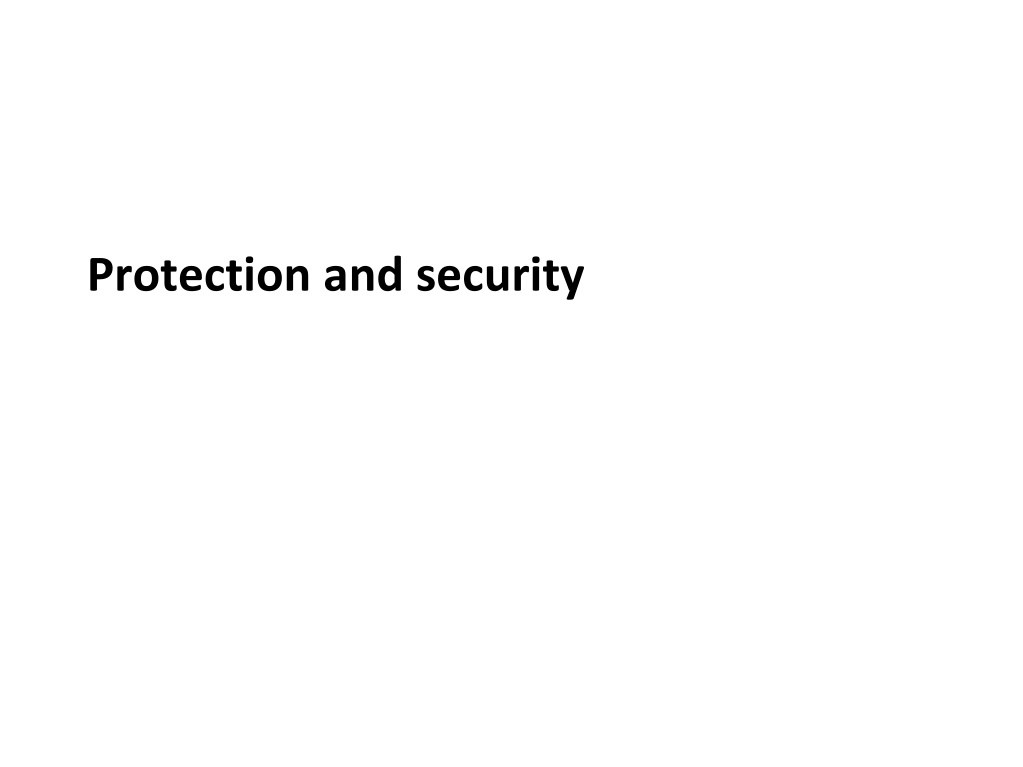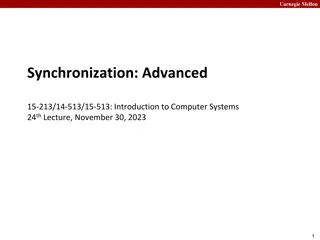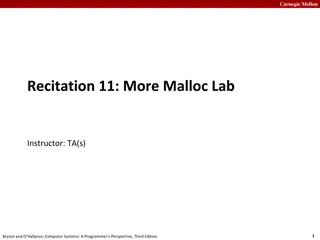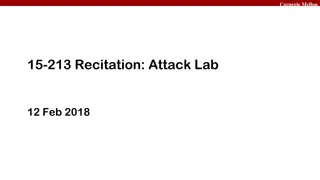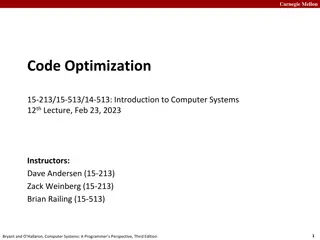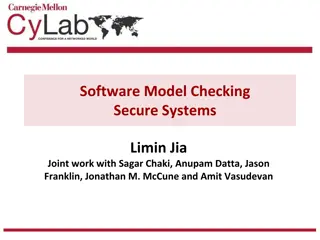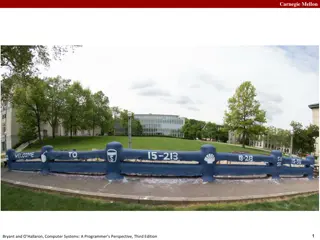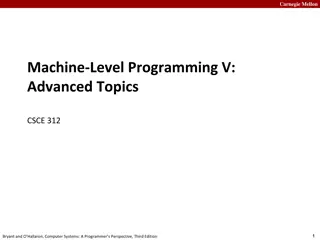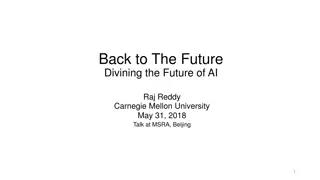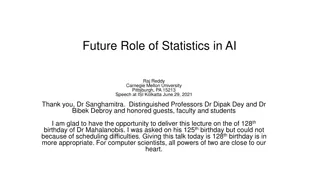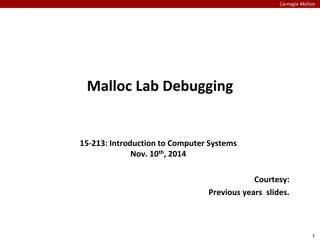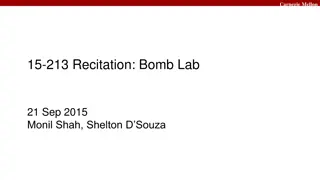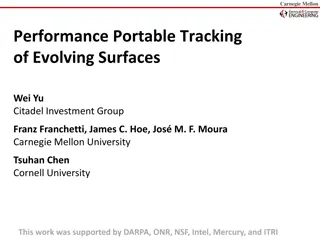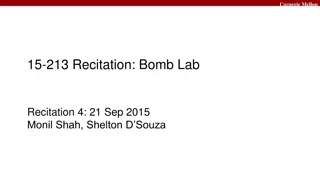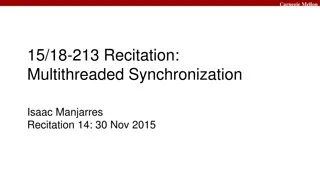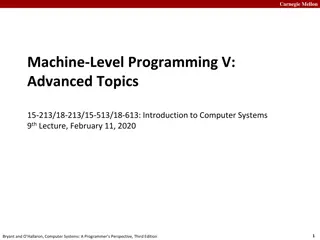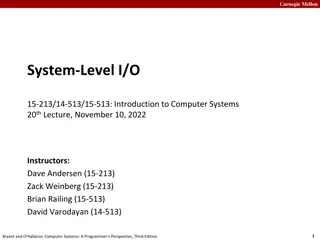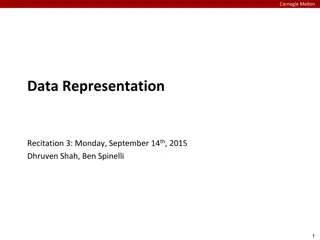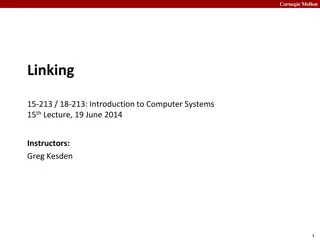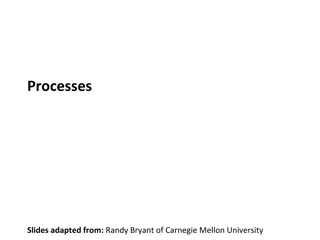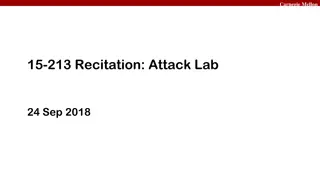Understanding Carnegie Mellon's Protection and Security Concepts
Carnegie Mellon University emphasizes the importance of protection and security in operating systems. Protection involves preventing unauthorized access by users, while security focuses on external threats and authenticating system users. The goals of protection include preventing access violations and enforcing resource use policies. Principles like the principle of least privilege guide the design of protection mechanisms. The domain of protection defines the objects and operations in an operating system, ensuring correct access control. Domain structure specifies resources that processes can access and the types of operations allowed on them.
Download Presentation

Please find below an Image/Link to download the presentation.
The content on the website is provided AS IS for your information and personal use only. It may not be sold, licensed, or shared on other websites without obtaining consent from the author. Download presentation by click this link. If you encounter any issues during the download, it is possible that the publisher has removed the file from their server.
E N D
Presentation Transcript
Carnegie Mellon Protection and security
Carnegie Mellon Protection and Security Protection: Preventing the access of internal users from accessing resources that they are not allowed to. To control the access of programs, processes or users to the resources provided within a computer system. Security: Preventing the access from external agents. To authenticate the system users to protect the integrity of the information stored in the system. Protection and security are related but different concepts of OS s.
Carnegie Mellon Goals of Protection Protection problem stems from multiprogramming OS s untrustworthy users can safely share common resources, such as memory, files. Protection Prevent violation of access restriction by a user Distinguish between authorized and unauthorized usage Provide a mechanism for the enforcement of the policies governing resource use Some are fixed during the design of the system Some are set by the management of the system Others are defined by the users of the system
Carnegie Mellon Principles of Protection Guiding principle principle of least privilege Programs, users and systems should be given just enough privileges to perform their tasks Ask: What is the lowest set of privileges allowable for this user s tasks? How long are the privileges required? If you hire a gardener, grant them access to your yard not your bedroom. grant them access for the time they re working
Carnegie Mellon Domain of Protection Operating system consists of a collection of objects, hardware or software Files, directories, hardware, .. A file can be readable but not writable.. Each object has a unique name and can be accessed through a well-defined set of operations. A CPU can only be executed on Memory can be read or written CD-ROM can only be read Protection problem - ensure that each object is accessed correctly and only by those processes that are allowed to do so.
Carnegie Mellon Domain Structure A protection domain specifies the resources that the process may access. Each domain defines a set of objects and the types of operations that may be invoked on each object. Domain = {access-right} access-right = <object-name, {right}> right = {read, write, execute }
Carnegie Mellon Domain structure Domain1 = { <file-A, {read, write, execute}>, <file-B, {read, execute}>, <page-2, {read}>, < printer-1, {print}>} P1 Domain2 = { <file-A, {read, write}>, <file-B, {read, execute}>, <page-1, {read, execute}>, < printer-1, {print}>} P2 Domains need not be disjoint. Both P1 and P2 processes can print on printer-1. Only P1 can execute file-A. Only P2 can read page-1.
Carnegie Mellon Domain Structure - static/dynamic Associations between a process and a domain can be Static Fixed at the time of creation of the process May need to provide more rights than needed at the run time Dynamic A process can switch from one domain to another The content of the domain can also be changed Domain1 = { <file-A, {read, write, execute}>, < printer-1, {print}>} P1
Carnegie Mellon Domain Structure - static/dynamic Associations between a process and a domain can be Static Fixed at the time of creation of the process May need to provide more rights than needed at the run time Dynamic A process can switch from one domain to another Domain1 = { <file-A, {read, write, execute}>, < printer-1, {print}>} P1 Domain2 = { <file-A, {read, write}>, <file-B, {read, execute}>, }
Carnegie Mellon Domain Structure - static/dynamic Associations between a process and a domain can be Static Fixed at the time of creation of the process May need to provide more rights than needed at the run time Dynamic A process can switch from one domain to another The content of the domain can also be changed Domain1 = { <file-A, {read, write, execute}>, < printer-1, {print}>} P1 Domain2 = { <file-A, {read, write}>, <file-B, {read, execute}>, < printer-1, {print}>}
Carnegie Mellon Domain design Each user may be a domain. Access rights depend on the identity of the user. Domain switching occurs when the user is changed. Each process may be a domain. Access rights depend on the identity of the process. Domain switching corresponds to one process sending a message to another process, and then waiting for a response. Each procedure may be a domain. the set of objects that can be accessed corresponds to the local variables defined within the procedure. Domain switching occurs when a procedure call is made As an example, user and kernel modes define a dual domain system where the processes that run in kernel mode have the right to execute privileged instructions. But we also need to protect users from each other!
Carnegie Mellon Domain Implementation (UNIX) A domain is associated with the user through uid (user id) and guid (group id) Switching domain = changing user identification temporarily Domain switch accomplished via file system. Each file is associated with An owner identification a domain bit (known as the setuid bit).
Carnegie Mellon setuid bit how passwd works How does the passwd program work When executed by the user, the process runs in the user s domain Cannot modify the /etc/passwd file! Solution: passwd program has its setuid bit set, that allows it to run with root access Modify /etc/passwd file User (with user-id = A) starts executing a file owned by B. When the setuid bit is off the user-id of the process is set to A. When the setuid bit is on, the user-id of the process is set to B.
Carnegie Mellon Model of Protection: Access Matrix View protection as a matrix Rows represent domains Columns represent objects Access(i, j) is the set of operations that a process executing in Domaini can invoke on Objectj O1 O2 O3 O5 read, write, execute, owner read access read, write D1 read, execute, switch(D1) read, write, owner access read, write D2 Read, write, access, owner read D3 access read, write, owner D4 access read, write D5 access read D6
Carnegie Mellon Access Matrix - dynamic protection Can be expanded to dynamic protection. Operations to add, delete access rights. Special access rights: owner of Oi copy op from Oi to Oj control Di can modify Dj access rights switch switch from domain Di to Dj
Carnegie Mellon Example: A Unix ls -l output and content of /etc/group Protection Owner Group Object -rwsr-x--- obi jedi useforce -rw-r----- luke jedi 3po.man drwx--x--x darth sith ds.plan -rw-rw-r-- han free mf.jpeg GroupName:ShadowPass:UserList jedi:x:yoda,obi,luke sith:x:emperor,vader,doku free:x:han,lea,obi,luke robot:x:r2d3,3po Access matrix: useforce 3po.man ds.plan mf.jpeg read, write, execute, owner read access read, write obi read, execute, switch(obi) read, write, owner access read, write luke Read, write, access, owner read darth access read, write, owner han access read, write lea access read r2d2
Carnegie Mellon Switching between domains A process executing in D2 can switch to domain D3 or D4 A process executing in D4 can switch to D1 Linux sudo implements a domain switch controlled in /etc/sudoers Allowing controlled change to the contents of the access-matrix entries requires three additional operations: copy , owner , and control .
Carnegie Mellon Access Matrix with Copy Rights The ability to copy an access right from one domain (or row) of the access matrix to another is denoted by an asterisk (*) appended to the access right. A process in D2 can copy the read operation into any entry associated with file F2 Example: SQL GRANT with GRANT OPTION : GRANT INSERT,DELETE ON TABLE mytable WITH GRANT OPTION;
Carnegie Mellon Access Matrix with Copy Rights Two possible variants: A right is copied from access (I,j) to access (k,j); it is then removed from access (i,j); this action is a transfer of a right, rather than a copy. Propagation of the copy right may be limited. That is, when the right R* is copied from access (i,j) to access (k,j), only the right R (not R*) is created. A process executing in domain cannot further copy the right R.
Carnegie Mellon Access Matrix With Owner Rights Owner rights should allow the addition of new rights and removal of some rights. Unix implements chmod() system call to update access matrix by owner.
Carnegie Mellon Access Matrix With Control Rights D2 can modify D4 row. For example: Unix root has control right on all other domains The copy and owner rights provide us with a mechanism to limit the propagation of access rights. However, they do not give us the appropriate tools for preventing the propagation (or disclosure) of information The problem of guaranteeing that no information initially held in an object can migrate outside of its execution environment is called the confinement problem.
Carnegie Mellon Implementation of Access Matrix How can the access matrix be implemented effectively? The matrix will be sparse; that is, most of the entries will be empty. Global table Access lists for Objects Capability lists for Domains A Lock-Key Mechanism
Carnegie Mellon Global Table A global table consisting of <domain, object, rights-set> triples D1 O1 read, write, execute, owner D1 O2 read, write D1 D2 O1 read, execute, switch(obi) D2 O2 read, write, owner D2 .
Carnegie Mellon Global Table pros and cons Simplest implementation The table is usually large and cannot be kept in memory Does not take into account special groupings of objects or domains If everyone can read a particular object, it must have a separate entry in every domain D1 O1 read, write, execute, owner D1 O2 read, write D1 D2 O1 read, execute, switch(obi) D2 O2 read, write, owner D2 .
Carnegie Mellon Access Lists for Objects For each object store <domain, rights-set>, which define all domains with a nonempty set of access rights for that object. can be extended easily to define a list plus a default set of access rights. Object1 D1 read, write, execute, owner D2 read, execute, switch(obi) Object2 D1 read, write D2 read, write, owner
Carnegie Mellon Access Lists for Objects - example For each object store <domain, rights-set>, which define all domains with a nonempty set of access rights for that object. can be extended easily to define a list plus a default set of access rights. Domain: User = {A,B,C} Object: File = {F1, F2, F3} Rights: {R, W, X}
Carnegie Mellon Capability Lists for Domains A capability list for a domain is a list of objects together with the operations allowed on those objects. The capability list is associated with a domain, but it is never directly accessible to a process executing in that domain. Rather, the capability list is itself a protected object, maintained by the operating system and accessed by the user only indirectly. Domain1 O1 read, write, execute, owner O2 read, execute, switch(obi) Domain2 D1 read, write D2 read, write, owner
Carnegie Mellon Capability Lists for Domains - example A capability list for a domain is a list of objects together with the operations allowed on those objects. The capability list is associated with a domain, but it is never directly accessible to a process executing in that domain. Rather, the capability list is itself a protected object, maintained by the operating system and accessed by the user only indirectly. Domain: User = {A,B,C} Object: File = {F1, F2, F3} Rights: {R, W, X}
Carnegie Mellon Lock-Key Mechanism The lock key scheme is a compromise between access lists and capability lists. Each object has a list of unique bit patterns, called locks. Similarly, each domain has a list of unique bit patterns, called keys. A process executing in a domain can access an object only if that domain has a key that matches one of the locks of the object. The list of keys for a domain must be managed by the OS on behalf of the domain. Users are not allowed to examine or modify the list of keys (or locks) directly.
Carnegie Mellon Access lists vs. Capability lists vs. Lock-key Access lists correspond directly to the needs of the users. When a user creates an object, she can specify which domains can access the object, as well as the operations allowed. Capability lists do not correspond directly to the needs of the users; they are useful, however, for localizing information for a given process. The process attempting access must present a capability for that access. The lock key mechanism is a compromise between these two schemes. The mechanism can be both effective and flexible, depending on the length of the keys. The keys can be passed freely from domain to domain.
Carnegie Mellon Authentication Crucial part of OS security. If a request is really done by a user/host that it claims. Host authentication: Mostly relates to network requests. Out of scope for this course. User authentication: done when user starts a session or asks a privileged operation. Authentication factors: Something (only) you know (password, pin code, TCKN?) Something you have (id card, credit card, cell phone, smart card) Something you are (finger, retina, blood, DNA sample )
Carnegie Mellon Password Authentication Relies on only user knows a common passphrase. User password is compared against the information stored on system. A match results in success. Password is the critical part of security. Protecting password database is crucial. Bad idea: storing passwords in plain. If protection of password database is compromised security of system collapses. Privileged users can see content. Use it for other systems Solution use cryptography. Hash/digest functions: map a string of bytes into a fixed string where: Given the result, original string cannot be computed Small change in input string ends up extensive changes in result, no correlation can be found. Having two input strings result in same has value is extremely unlikely.
Carnegie Mellon Password Authentication User passwords are stored in database as crypto hashed values. With cryptohash() function, authentication becomes: Input uname and plain password ppass from user Calculate cpass = cryptohash(ppass) Check password database for an entry username==uname and password == cpass No cryptohash(cpass) function giving ppass is defined. POSIX define crypt(key, salt) functions for password test: strcmp(crypt(ppass, salt), cpass) == 0 /etc/shadow is used as password store in a standalone Unix/Linux system Not a perfect solution, vulnerable to: Dictionary attacks: Test all possible passwords from a dictionary Social engineering attacks: Learn information from user, birthday, team he is supporting etc. Key-loggers intercepting user input and reporting to third parties.
Carnegie Mellon One Time Passwords (OTP) Major problem in password authentication is its lifetime. A user can use same password for year. Frequent changes of password/pin code is required. OTP uses cryptography to generate dynamic passwords as user is authenticated or by time. Sequence based: OTPt = otpgen(secret, OPTt-1) Time based: OTPt = otpgen(secret, time of day) User cannot compute otpgen so either it is precomputed or s/he is given a device to generate OTP s as needed: OTP token devices / cell phone applications OTPs turn into something you have factor authentication
Carnegie Mellon Third Party Authentication As implementing password or OTP based authentication per target system gets complicated, authentication may need to be centralized. User asking for authentication is sent to authentication services on network. User authenticates him/herself in server, gets a ticket. Ticket is given back to the original system to finish authentication. Cryptography makes sure ticket is coming from the trusted service. Protocols and services exists like kerberos, Openid, Oauth
Carnegie Mellon Multi-factor Authentication High security systems and software requires at least two factor in authentication: password + mobile SMS Credit card + pin code Retina scan + id card Something you have and something you are requires hardware devices to implement Fingerprint scanners Retina scanners Smart cards + readers Mobile phones SIM cards
Carnegie Mellon Other Uses of Cryptography in OS Cryptographic hash functions/digests: Integrity of data. If a file (i.e. a system binary) has changed in system. For example a virus. Software package authentication. Symmetric cryptography: Data privacy. Encrypted content (disk, files, messages) Public key cryptography: Integrity of data (message signing and verification) Authentication (electronic certificates) Encryption (encryption without shared key) Key exchange
